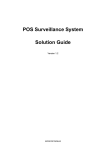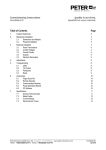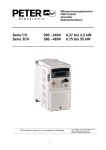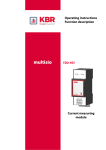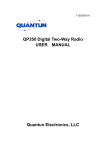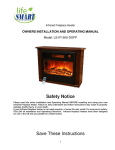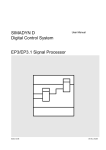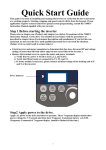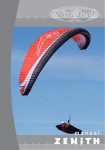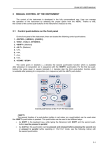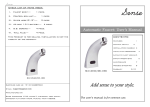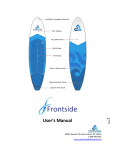Download Braking Unit for Frequency Inverter Serie 3CV 380 – 480V 18,5 bis
Transcript
User manual Braking Unit for Frequency Inverter Serie 3CV 380 – 480V PETER electronic GmbH & Co. KG, Bruckäcker 9, D-92348 Berg 18,5 bis 55kW Tel. (09189) 4147-0, Fax (09189) 4147-47 eMail: [email protected] Internet: www.peter-electronic.com PREFACE Braking unit is used to consume regenerative energy from motor in the braking resistor at deceleration and to improve the inverter braking ability. Before using the braking unit, a through understanding of this manual is recommended. This instruction manual will be a great help for daily maintenance, inspection and troubleshooting. The Braking unit can be connected as FUS … /3CV. Bei der Zusammenstellung von Texten und Abbildungen wurde mit größter Sorgfalt vorgegegangen. Trotzdem können Fehler nicht vollständig ausgeschlossen werden. Herausgeber und Autor können für fehlerhafte Angaben und deren Folgen weder eine juristische Verantwortung noch irgendeine Haftung übernehmen. Für Verbesserungsvorschläge und Hinweise auf Fehler sind wir dankbar. 1 Stand 08/06 1F000.10002 CONTENTS NOTES FOR SAFE OPERATION 1. RECEIVING 6 2. ENVIRONMENTAL PRECATION 6 3. MODEL-IDENTIFICATION 7 4. SPECIFICATION 7 5. SECTION NAME 5.1 Circuitry terminal description 5.2 Jump function description 8 8 9 6. DIMENSION 9 7. WIRE PRECATIONS 7.1 Circuits and wire specification 7.2 Wire distance 10 10 8. INTERCONNECTION 8.1 One braking unit installation 8.2 Parallel connection of braking units 8.3 Braking unit and braking resistor unit application list 11 11 11 12 9. TROUBLESHOOTING 13 2 NOTES FOR SAFE OPERATION The following conventions are used to indicate precaution in this manual. Failure to heed precaution provided in this manual can result in serious or possibly even fatal injury or damage to the products or to related equipment and system. CAUTION:Indicated precaution that, if not heeded, could result in relatively serious or minor injury , damage to the product, or faulty operation. DANGER:Indicated precaution that, if not heeded, could possibly result in loss of life or serious injury. ───────────RECEIVING────────── Do not install or operate any braking unit which is damaged or has missing parts. ─────────────INSTALLATION─────────── Lift cabinet by the base, when moving the unit, never lift by the front cover. Otherwise, the main unit may be dropped causing damage to the unit. Mount the braking unit and resistor on nonflammable material. Failure to observe this caution can result in a fire. When mounting braking unit (Individually or multiple) in an enclosure, install a fan or other cooling device to keep the intake air temperature below 40 . Over hearting may cause a fire or damage to the unit. ─────────────WIRING──────────── Connect the Inverter’s DC bus terminal N、P to Braking unit’s main circuit terminal N(-)、P(+) properly. Otherwise, the Inverter or Braking unit will be damaged. 3 Always turn OFF the input power supply and wait until the CHARGE indicator light goes out before wiring terminal. Otherwise, an electric shocks or fire can occur. Do not touch the Braking unit and Braking resistor while power is applied to the circuit. Failure to observe this warning can result in personal injury. Wiring should be performed only by qualified personnel. Failure to observe this warning can result in an electrical shock or a fire. Make sure to earth the ground terminal class 100Ω or less, 400V class 10Ω or less. , Grounding resistance 200V When wiring the emergency stop circuit, check the wiring thoroughly before operation.Failure to observe this warning can result in personal injury. Never touch the fins (heat-sink) of the Braking unit or discharge resistor. These can become very hot. Failure to observe this warning can result in personal injury. Install the discharge resistor on nonflammable material, provide sufficient spaces from other devices, the 1 meter distance are recommend, Failure to observe this caution can result in a fire. Verify that the rated voltage setting jumper of the braking unit coincides with the Inverter input supply voltage. Failure to observe this caution can result in personal injury or a fire. Tighten terminal screws to the specified tightening torque. Failure to observe this caution can result in a fire. Do not perform a withstand voltage test of the braking unit and braking resistor unit. It may cause braking unit inside element to be damaged. ─────────────OPERATION──────────── Do not remove the cover while the power is ON, current is flowing. Failure to observe this warning can result in an electrical shock. Do not check signals during operation. The Braking unit or the Inverter may be damaged. 4 Never touch the discharge resistor. These can become very hot. Failure to observe this warning can result in personal injury. Never modify the product, Failure to observe this warning can result an electrical shock or personal injury and will invalidate the guarantee. ────MAINTENANCE AND INSPECTION────── Perform maintenance or inspection only after verifying that the CHARGE LED goes OFF, after the main power supply is turn OFF. The capacitors are still charged and can be dangerous. Never touch high-voltage terminals in the braking unit and braking resistor. Failure to observe this warning can result in an electrical shock. Only authorized personnel should be permitted to perform maintenance, inspection or parts replacement. Failure to observe this warning can result in an electrical shock. 5 1. RECEIVING The braking unit has been put though several tests at the factory before shipment. After unpacking, however, check and see the following. Their model and capacity of the braking unit meet your requirement. Is there any damage while transportation. If so, do not apply the power. If any of above is found, contact nearest distributor or sales representatives. 2. ENVIRONMENTAL PRECATION The environment will directly affect the proper operation and the life of the braking unit, so install the braking unit in an environment complies with the following conditions: Ambient temperature: -10°C - +40°C; (take the dustproof cover off : -10°C - +50°C) Avoid exposure to rain or moisture. Avoid direct sunlight. Avoid smoke and salinity. Avoid erosive liquid and gas. Avoid dust, bats, and small metal pieces. Keep away from radiative and flammable materials. When mounting multiple braking units are placed in the same control panel, add extra heat dissipators to keep the temperature below 40°C. Place the front side of the braking unit onward and top upward to help heat dissipation. Install the inverter according to the following figures: (take the dustproof cover off to help heat dissipation if installed in a box or the environment allows to do so) 6 3. MODEL-IDENTIFICATION Model name TBU - 4 Series 30 Applicable Inverter voltage Applicable motor rated capacity 4: 380 - 480V 30: 30Hp 4. SPECIFICATION Applicable Inverter voltage 380V - 480V Braking unit model TBU-430 Output Characteristics Applicable Motor Output 18,5kW – 55kW Rated Discharge Current (A) 15 Max Discharge Current (A) 40 618/651/716/748/781VDC Braking Start Voltage (VDC) →±6V Power Supply Prot. Function Environment Conditions Inverter Input Voltage 380 - 480VAC Inverter DC BUS Voltage 460 - 800VDC Overheat Thermostat (with contact output) Power Charge Indication Charge lamp stays ON until bus voltage drops below 50VDC Location Indoor (Protected from corrosive gases and dust) Ambient Temperature - 10°C - + 40°C Storage Temperature - 20°C - + 70°C Humidity 0 - 95%RH (non-condensing) Vibration 1g less than 20Hz;up to 0.3g at 20 - 50Hz Enclosure IP20 Safety level CE/UL/cUL Installation Screw mounted Parallel connection Parallel connection of braking unit is possible to use in the inverter with bigger horsepower Dimension (W*H*D) 149mm * 184mm * 146mm ● Loading time rate can be used below 10%ED (max. 10s) 7 5. SECTION NAME 5.1 Circuitry terminal description Purpose Terminal Symbol P(+) Main circuit power input N(-) BR+ BR- Description DC-Bus power input terminals (P(+) positive terminal, N(-) negative terminal) Braking resistor output terminals. (Resistor specification please refer to braking resistor list) Grounding terminal Control circuit SL+ Parallel connect Slave input positive terminal SL- Parallel connect Slave input negative terminal MA+ Parallel connect Master input positive terminal MA- Parallel connect Master input negative terminal OH+ Braking unit over-heat protection relay output terminal (1A/125VAC, 2A/ 30VDC) OH- 8 5.2 Jump function description Description JP1 JP2 Braking unit power supply voltage selection; selected the properly voltage level to make the braking start level corrected. Master / Slave station selection Master station: MASTER-COM, (Factory default) Slave station: SLAVE-COM (Only multiple braking units needed) 6. DIMENSION 9 7. WIRE PRECATION 7.1 Circuits and wire specification Braking Purpose Terminal Symbol unit Wire sizes AWG (mm²) Wire type Terminal Screws N(-),P(+) Main circuit BR+,BR- Control circuit SL+ ,SL-, MA+, MA-, OH+, OH- TBU-430 12-10 (3.5-5.5 mm²) Power cables, e.g., 600V, vinyl power cables 18-14 (0.75-2 mm²) M4 M3 7.2 Wire distance Since the braking unit and braking resistor generates heat, provide sufficient spaces from other devices which are weak against heat. Make sure to ground the grounding terminal , use the properly wire and tighten M4 terminal screws to the specified tightening torque. 10 8. INTERCONNECTION Braking units have a master/slave selection connector, the master side selected prior to shipment, for using more than one parallel connected braking unit, selected slave side for braking units second unit and above. 8.1 One braking unit installation (One Inverter connected to one braking unit) N N (-) SL + P P (+) SL MA + MA - Master Inverter 480 460 440 BR + 400 OH + BR - 380 OH - 8.2 Parallel connection of braking units (One Inverter connected to multiple braking units) N N (-) P P (+) Braking unit 1 SL + SL + SL - SL - MA + Inverter Braking unit 3 N (-) SL + N (-) P (+) SL - P (+) MA + Slave MA - Master Braking unit 2 MA + Slave MA - MA - 480 480 480 460 460 460 440 440 BR + 400 OH + BR - 380 OH - * 440 BR + 400 OH + BR - 380 OH - * Thermostat with relay: 1A/125VAC 2A/30VDC 11 * BR + 400 OH + BR - 380 OH - * For using multiple braking units need to parallel connected the barking units’ main circuit terminal and selector the jumper 2(JP2) as follows: 1) Braking unit 1 as the Master station, check the JP2 selection is in MASTER-COM. 2) Braking unit 2 & 3 as the Slave station. Make sure the JP2 selection is in SLAVE-COM 3) Connect braking unit 1 terminal MA+,MA- to braking unit 2 terminal SL+,SL-, Braking unit 2 terminal MA+,MA- to braking unit3terminal SL+,SL-. 4) Braking unit terminal BR+,BR- connect to braking resistor. 5) Make sure all the braking unit JP1 (voltage selection) selected corrected, then the parallel connection braking units start level will coincide. 8.3 Braking unit and braking resistor unit application list INVERTER Braking Unit Braking Resistor Braking Voltage kW Braking Unit Q’ty MODEL NO. Resistor Min Q’ty Specification Ohm Value Approx. Braking Torque (10%ED) 18,5 TBU-430 1 1200W/30Ω 4 19.2Ω 119%(10%ED) 22 TBU-430 1 1200W/30Ω 4 19.2Ω 117%(10%ED) 380V – 30 TBU-430 1 1500W/20Ω 4 19.2Ω 119%(10%ED) 480V 37 TBU-430 2 1200W/30Ω 8 19.2Ω 119%(10%ED) 45 TBU-430 2 1200W/30Ω 8 19.2Ω 117%(10%ED) 55 TBU-430 2 1500W/20Ω 8 19.2Ω 126%(10%ED) Select the braking resistor by this list. Failure to observe this warning can damage to the unit. 12 9. TROUBLESHOOTING Fault Status Braking unit or resistor acted when the Inverter during the acceleration or constant speed. Make the resistor over load Cause Corrective Action Without braking unit: Repair the Inverter’s braking Inverter built-in braking discharge circuit. transistor is in short circuited. Replace the Inverter With braking unit: Repair the braking unit’s Braking unit discharge transistor is braking circuit. in short circuited. Replace the Braking unit Improper selection the input voltage level J2, (Power supply voltage > braking unit’s power supply voltage selection). Set the correct JP2 position. Input power voltage high than the Improved the input power voltage specification. voltage. Inverter trips at over voltage (OV) Insufficient braking capacity Examine the braking capacity. Increase inverter’s deceleration time Improper wiring Check the wire Braking unit malfunction Replace the Braking unit Inverter Start/Stop frequently Examine the operating condition Load inertia too heavy Braking unit trips by Improper combination of braking heat sink over heat unit and transistor Selective by specification Ambient temperature above 40°C Check the location conditions 13














